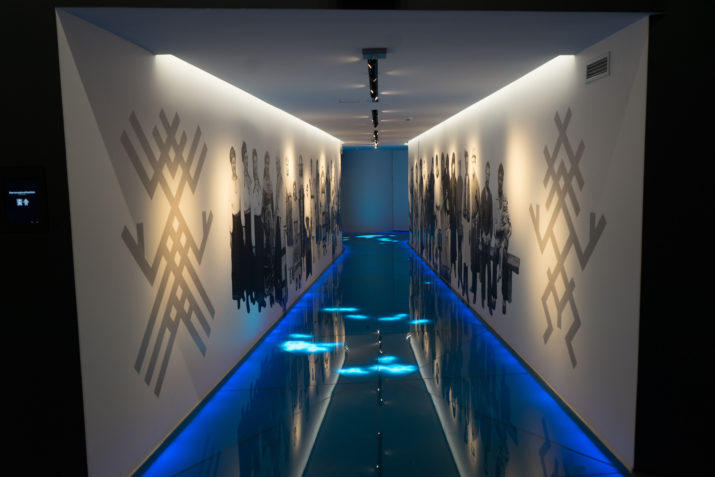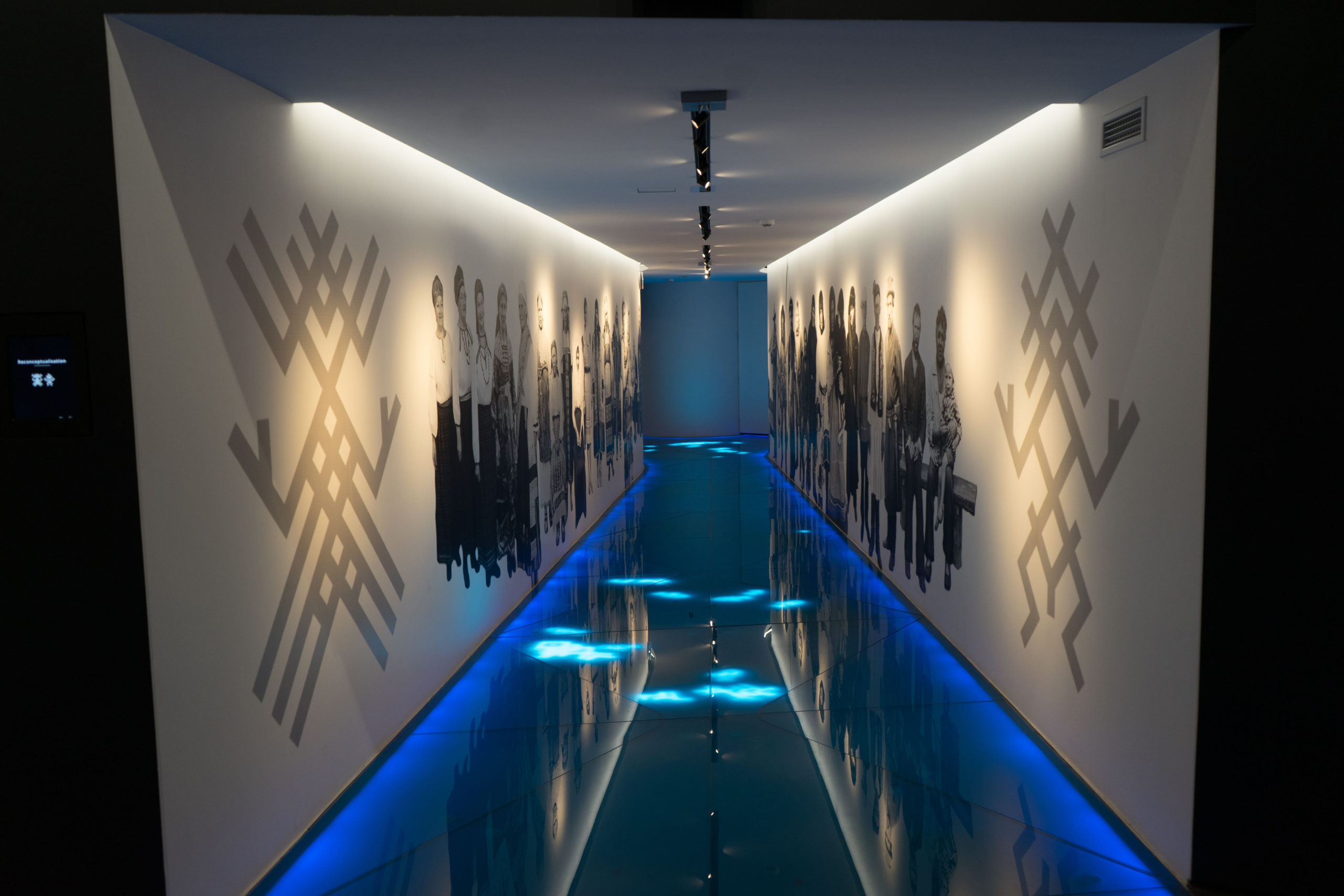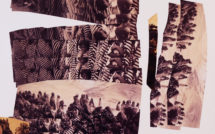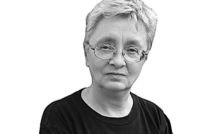

This is part of our special feature, Decolonizing European Memory Cultures.
Russia’s 2022 assault on Ukraine has energized and amplified debates about colonialism, post-colonialism, and decolonization in a region of the world largely overlooked by the global conversation on these topics: East-Central Europe (ECE). That these World War II “bloodlands”—as historian Timothy Snyder famously called the area where Nazi Germany and the Soviet Union violently clashed and where Holocaust and ethnic cleansing took place on a massive scale—might also be viewed as lands of colonial violence[1] requires a number of conceptual shifts. In both scholarly and public spheres, such re-orientations have entailed entertaining the notion that colonialism has been perpetrated not only by Europe but within it. This rethinking has involved the notion of “internal colonialism,” for example in multi-ethnic Galicia by the Polish-Lithuanian Commonwealth in the early modern world, by the Austro-Hungarian Empire in the nineteenth century, or by the Second Polish Republic in the interwar period. During the Cold War, while the Soviet Union supported overseas decolonial movements,[2] it was itself simultaneously a colonizer of multi-ethnic republics and a sovereign satellite states “at home.”[3] Moreover, “whiteness” has existed on a spectrum,[4] and racism has functioned beyond skin color. Finally, we must contend with the idea that serfdom, which lasted centuries longer in the ECE than in Western Europe, might have been comparable in its depredations to the New World’s plantation slavery.[5]
Within the ECE region, right-wing conservatives have eagerly embraced the discourse of colonialism to their own advantage to promulgate exclusivist notions of ethno-national pride, along with, at times, anti-EU narratives[6] and policies. However, liberal intellectuals and civil society activists must also do self-critical work. Both groups should confront not only the legacies of national glory and victimhood, but also the idea that their (imagined) historical communities were beneficiaries, intermediaries, even at times perpetrators of colonial domination and violence. ECE societies must also face the fact that their white privilege and European location in the global ecumene leave them far better off than their counterparts in the Global South, and that ECE actors’ own marginal otherness does not make them immune to racially discriminating against more precariously positioned others.
The recent proliferation of conversations on these themes has touched only very lightly on decolonial museology, which is our particular area of interest. Museums have been the focus of debates that have reached a fever pitch in Western European capitals in particular. There, the institution has emerged as a central public flashpoint for discussions about colonialism and decoloniality. Our goal here is to suggest that ECE museums present a rich and largely untapped resource for productively addressing the issues outlined above. Indeed, museums can uniquely bridge colonialism’s discursive-representational and material-economic aspects.
Museums in the ECE region embody institutional histories and physical infrastructures that are ripe with opportunities for both research and creative engagement. These opportunities include collections from overseas whose provenance has only just begun to be critically assessed. Among them are human remains and traces from pre-World War I “ethnographic shows” that displayed exoticized non-European bodies to popular local audiences not only in Paris and Berlin but also in Budapest, Lubljana, Prague, and Warsaw.[7] Regional museums also comprise enduring interpretive and curatorial strategies that present local peasant,[8] Jewish,[9] and Roma[10] populations in stereotypical, dehumanizing ways that beg decolonial approaches. Such material effects are, of course, supported by engrained habits of looking and listening, and ideas about expertise and authority—often encoded in policy—that demand critical review.
Nonetheless, these histories also represent important sources of knowledge for enriching and expanding the global conversation about decolonizing museums. Western colonial models were, and continue to be, reshaped in ECE. The region, situated anxiously between Western and Russian/Soviet empires, is characterized by intensely layered residues of violence and expropriation (via feudal serfdom, war, the Holocaust, ethnic cleansing, and communism) as well as by political aspirations fueled by its “second world” status. These circumstances demand new approaches and concepts: Erica Lehrer’s notion of “implicated communities” is one such concept (bringing Michael Rothberg’s notion of “implicated subjects” to bear on the social and ethical entanglements of museum objects), [11] and Bukowiecki, Wawrzyniak, and Wroblewska’s idea of the “duality of decolonization” (describing heritage interventions that simultaneously critique the legacies of foreign dependencies and nationalist essentialisms of these) constitutes another. [12] The reasons why museums in ECE have been thus far largely immune to current decolonial politics also relates to the absence in the region of empowered minority communities and/or a robust civil society with a multicultural mandate. These regionally specific challenges are themselves illuminating, as they help to define the task and relevance of decolonizing museums in East-Central Europe and beyond.
If we accept the need to decolonize ECE museums in principle, debates over the relevance in the region of terms such as “post-colonialism”[13] point to the need for context sensitivity. Imposing imported decolonial discourses and toolkits whole cloth risks erasing distinct local realities both historical and contemporary. That said, approaches pioneered in large part by Indigenous (and Global South) activists[14] working not only to reclaim their cultural materials and correct their representations but to fundamentally re-shape museum-community relationships,[15] offer some inspiration. Given the multiple, historically entangled[16] colonialisms and their legacies, collaborative work by thinkers situated in diverse global locations is needed to develop a robust toolkit for interrogating and ameliorating inherited museum structures and practices. With these many factors in mind, we propose a few basic steps that scholars and practitioners interested or acting in the ECE region might take in pursuit of a geosituated contribution to decolonial museology:
1. Identify and publicly acknowledge colonial continuities in material structures, social practices, and habits of mind. A crucial, basic gesture is to challenge the prevailing “defense” in the ECE region that since “we had no colonies,”[17] decolonization projects do not apply. North America’s Black Lives Matter movement has drawn powerful new attention to the enduring and systemic nature of anti-Black racism and White supremacy, as well as to the legacies of an imperialist, Enlightenment, Christian European worldview that has framed (and was imposed on) what came to be viewed as the “non-West.” These frameworks still prevail in European (and Euro-dominant) national societies and their museums, as well as institutions elsewhere that seek to emulate them. Museums themselves have served as fundamental colonial technologies as they have categorized and hierarchized the world based on material “evidence” of European taxonomies. Such views persist in present-day systems of classification and hierarchies of knowledge in ECE museums. They are also visible in the language used in interpretive texts, in forms of accessibility to spaces and collections, and in the very different kinds of social relevance that museums and their objects have to different communities. To reveal these distinctions, it is necessary to critically inquire[18] about who is made to feel at home in museum spaces, whose stories are told, whose knowledge and experiences are legitimized, whose values are dignified, whose emotions are acceptable, and whose bodies are made to feel comfortable.
2. Map the landscape of collections from overseas in ECE institutions, including museums, religious institutions such as churches, convents and monasteries, and private collections. It is necessary to make their provenance known, and—to the extent possible—to illuminate the histories of contact with and violence against “source communities.” In their aspirations to equal status in Europe, ECE museums have taken Western museums as their models. The collections of ECE museums were also amassed as a result of ECE countries’ semi-peripheral position within the racialized power relations of the colonial world system. ECE-born aristocrats, scholars, missionaries, and explorers were able to join with their Western imperial counterparts to gather objects from colonized and oppressed people by “piggybacking” on existing imperial structures. In a complex equation of “disempowered privilege,” some Polish collectors who found themselves in Siberia as forced political exiles[19] also gathered objects from Indigenous groups colonized by the Russian empire.[20] Foreign objects, bones, and even graves of overseas “others” who traveled to ECE to perform their cultures have marked the region, but their existence has often fallen into obscurity and been separated from relevant documentation. Surveying ECE institutions is a fundamental step in making the colonial history of the region visible. The vast and repeated transfers of property on both local and transnational scales, in addition to nationally specific experiences of plunder and ideological expropriation, make this a complex task. Researching and publicizing the processes, practices, and politics of domestic “rural” collecting is also crucial. These activities help to reveal both collections traceable to “internal colonialism” and continuities of colonial epistemologies embedded in museum practice as applied to local minoritized groups. Similarly, identifying where plundered ECE regional objects[21] currently reside is a valuable parallel project, but its right-wing nationalist political sponsorship should be recognized.
3. Trace the layered histories of ECE museums and collections under empire and occupation. Research is required (and beginning to be undertaken by regional scholars) to identify the impact of multiple regimes on the existence, structure, and classification systems of collections, as well as these powers’ enduring traces in discourses and representations of self and other. These regimes include Russian, Prussian, Austro-Hungarian, and Ottoman empires; moreover, German and Russian WWII occupations and later Cold War Soviet policies have also influenced these collections (the latter based on an ideological solidarity with the Global South). Today’s ECE collections often bear the marks of sequential expropriations due to regime and border changes, population transfers, and wartime looting. These can be difficult to disentangle. Jewish and Roma communal collections can, further, tell us about provisional inclusion and “internal” othering, as well as about minority strategies of resistance and collaboration.[22] Indeed, today’s national collections, which represent the region’s dominant ethnic groups, themselves emerged as forms of resistance under empire and are being repurposed by some today for nationalist revival projects.
4. Survey the range of emerging decolonial curatorial debates, practices, and policies, as well as resistance to these, in ECE museums, galleries, and other heritage sites. Preliminary examples can be seen in Estonia;[23] Latvia;[24] Poland;[25] the former Yugoslavia[26]/Serbia[27]); Ukraine;[28] and even Russia.[29] Museum directors, curators, and educators could be interviewed to determine where and how they encounter, understand, and employ ideas about colonialism and decolonization. Understanding those actors who champion or resist decolonization, as well as those who undertake it regressively, will help reveal similarities to and differences from how the process is unfolding in other regions.
5. Engage perspectives of implicated communities. In Western Europe, the United States, and the British Commonwealth, a decisive engine of progressive change in museums has been the activism of communities that have been the main victims of the damage that colonial museology has inflicted. These communities continue to be excluded, misrepresented, underserved, or mistreated by museum institutions. Museums must take the lead in pursuing decolonial work to educate their own, majority white audiences. However, it is impossible to do the necessary decolonial work without centering the voices, knowledge, and experiences of those who have been marginalized. This process includes both the ECE region’s historical (often decimated) communities, overseas “source communities,” and the more recently in-migrated ethnic groups and members of “global majority” communities (who are viewed as minorities in ECE countries).[30] Even well-meaning projects that continue to sideline these groups risk re-inscribing the very hierarchies that decolonial work is trying to dismantle and may inflict further wounds precisely where repair is needed. Current ECE demography makes realizing this demand for plural participation challenging, particularly in countries such as Poland. Indeed, despite the violent loss of much of their historical diversity during and after World War II, Polish collections still contain the material heritage of non-Slavic/non-Christian/non-white communities. Museums must actively seek out members of both historical and more recently implicated communities and create enduring structures and policies by which to collaboratively explore what knowledge might be shared. Museum professionals must also explore what their institutions could offer that these groups would find valuable, ask where museums continue to fall short or inflict further damage, and fairly remunerate communities for their consultation work. Intimate techniques such as oral historical research or artistic production can help illuminate trauma and memory associated with institutions and their collections, offering a useful entryway into layers of unprocessed, often invisible difficult knowledge relevant to ECE societies.
6. Bring the intellectual and creative work on de/coloniality produced by ECE scholars, curators, and activists into global conversations on the topic. It is necessary to draw on critical theory developed in the region.[31] Treating ECE scholars as capable only of applying Western ideas locally or serving as a source of “raw material” for Western theorists to refine into new conceptual contributions replicates colonial relations in problematic ways.[32]
7. Create materials to engage museum workers in the ECE region regarding the relevance of decoloniality. Creative strategies must also be developed to employ museums, collections, and heritage sites to involve broad publics in debates about colonial histories. These strategies must include an attempt to understand how people local to the ECE region understand and experience notions of colonialism, imperialism, and race, as well as the calls to work against their legacies and resurgences.
8. Empower progressive civil society projects and actions in the culture sector. Particularly in Hungary and Poland but also in other countries in the region, public funds have been appropriated by right-wing conservatives who have fostered an ethno-nationalist politics of memory. Material and intellectual resources are needed to counterbalance this trend, in museums as well as in the academic and culture/heritage sectors more broadly.
In singling out the ECE museumscape for decolonial attention, we are mindful of the pitfalls of pathologizing, orientalizing, and neo-colonizing. The widespread silence in the East-Central European museum sector regarding “decolonization” cannot simply—and paternalistically—be attributed to a game of catch-up, with the idea that this “other Europe” simply needs time to fall into line. Western Europe’s attention to its difficult colonial heritage has itself been recent and fitful. Broad rejection of Western Europe’s responsibility for vast violence and plunder (and a continued embrace of a façade of innocence tied to Europe’s supposed “civilizing mission”) began cracking only in the first two decades of the 2000s. Even as restitution projects are being normalized,[33] ideas about ownership of cultural property are renegotiated, and museums drop colonial-era disciplinary terms like anthropology and ethnology from their names, debates continue to rage in Belgium, France, Germany, the Netherlands, and the UK.
Decolonial discourses have indeed been trickling in to ECE institutions from the West via museum studies conferences and educational programs attended by ECE participants and visiting scholars. The work ahead, then, is to investigate how these influences are being met with a complex of political and socio-emotional realities; these realities point to important historical and structural differences that will generate an East-Central European regional approach to “decolonial” museum critique and curatorial practice. Careful attention to the specificities of this critique may raise useful new questions about research and practice that can productively inform the contours of the broader global debate.
We are also mindful of discussions regarding the political projects of Indigenous people in North America who insist that decolonization should not be treated as a metaphor.[34] Doing so risks diminishing the concept’s power within Indigenous struggles for sovereignty and land reclamation, which are central aspirations in settler colonial contexts. Yet as important as it is to support Indigenous claims and to honor the incommensurability of various experiences of oppression, attention to the specificities of different cases (including Indigenous struggles in Estonia and Russia) can enrich global understandings of colonialism and decolonization in important ways. Approaches to decolonial museology pioneered by Indigenous and Global South actors should inform the budding discussions taking place in ECE. The conceptual vocabulary regarding colonial museology can be made more robust and expansive, and areas for knowledge-sharing and solidarity can be identified, without diluting the pursuit of justice for Indigenous communities still acutely suffering the ongoing legacies of settler colonization.
To this end, we draw attention to our current collaborative project Decolonial Museology Recentred: Thinking Theory and Practice Through East-Central Europe, which includes Joanna Wasilewska, Director of Warsaw’s Asia and Pacific Museum and a group of Poland- and Canada-based students,* in pursuit of the aims enumerated above.[35] Along with an edited volume featuring new works by scholars from the region grappling with the specific challenges of decolonizing ECE museums (to be published in 2023), we are in the process of convening a minority consultation committee in Poland with whom we are developing a set of decolonial policy recommendations for the Polish museum sector.** We also recently established (and—as of publishing time—will by summer 2024 be launching) a Polish language website, www.dekolonizacjamuzeow.pl, where a range of decolonial tools and projects will be accessible for museum and heritage professionals and educators.
We have tried in this short text to highlight the most pressing tasks facing curators, educators, and artists in order to catalyze a decolonial conversation in, and in relation to, East-Central European museums. While the future of this discussion is open ended, ultimately, it may be Ukrainian scholars,[36] activists,[37] and artists[38]—many as global refugees—who will serve as the decisive catalyst in stretching the question of decolonizing[39] museums in a way that connects both halves of the continent and beyond. While their thought leadership in the realm of culture may at times risk new (if understandable) ethnocentrism and nationalism, it also offers a crash course in expanding our grasp of Europe’s multiple colonialisms.
Erica Lehrer is Professor in the Departments of History and Sociology-Anthropology at Concordia University in Montreal. She is Principal Investigator on the international team project Thinking Through the Museum: A Partnership Approach to Curating Difficult Knowledge in Public, funded by the Canadian Social Science and Humanities Research Council (2021-2028).
Joanna Wawrzyniak is Associate Professor of Sociology and Director of the Center for Research on Social Memory at the University of Warsaw. She is co-editor of a special issue of Memory Studies (2022, 15/6) titled Mnemonic Wars: New Constellations.
* Graduate student and postdoctoral research assistants include: Łukasz Bukowiecki, Magda Bodzan, Agnieszka Frasunkiewicz, Aneta Kopczacka, naveed L. salek nejad, Anna Pruszyńska, and Zofia Rohozińska.
** Sara Alexandre, Thuy Duong Dang, Magda Rubenfeld Koralewska, Thuc Linh Nguyen Vu, Amaka Ohia-Nowak, Mustafa Switat, and Joanna Talewicz.
References
[1] Jürgen Zimmerer, “Historian Jürgen Zimmerer on Germany’s other genocide,” interview by Alexander Wells, Exberliner, March 12, 2020, https://www.exberliner.com/politics/jurgen-zimmerer-interview/.
[2] James Mark and Quinn Slobodian, “Eastern Europe in the Global History of Decolonization.” In The Oxford Handbook of the Ends of Empire, eds. Martin Thomas and Andrew S. Thompson (Oxford University Press, 2018), 350–72, https://doi.org/10.1093/oxfordhb/9780198713197.013.20.;
[3] Madina Tlostanova, “Between the Russian/Soviet Dependencies, Neoliberal Delusions, Dewesternizing Options, and Decolonial Drives,” Cultural Dynamics 27, no. 2 (July 1, 2015): 267–83, https://doi.org/10.1177/0921374015585230.
[4] Tomasz Zarycki, “On the Relevance of the Polish and East European Experiences in the Study of Global ‘Race’ Regimes,” Sociological Forum 37, no. 1 (2022): 326–32, https://doi.org/10.1111/socf.12797.
[5] Mikołaj Gliński, “Slavery vs. Serfdom, or Was Poland a Colonial Empire?,” Culture.pl, October 8, 2015, https://culture.pl/en/article/slavery-vs-serfdom-or-was-poland-a-colonial-empire.
[6]Simon Taylor, “Orbán Accuses EU of Colonialism” Politico, March 16, 2012, https://www.politico.eu/article/orban-accuses-eu-of-colonialism/.
[7] Dominika Czarnecka, and Dagnosław Demski, “Contextualizing Ethnographic Shows in Central and Eastern Europe,” East Central Europe 47, no. 2–3 (2020): 163-172.
[8] SOKOL Małopolskie Centrum Kultury, “Exhibition Pany Chłopy Chłopy Pany,” June 24-September 11, 2016, https://mcksokol.pl/en/exhibition/pany-chlopy-chlopy-pany-1
[9] Erica Lehrer and Monika Murzyn-Kupisz, “Making Space for Jewish Culture in Polish Folk and Ethnographic Museums,” Museum Worlds 7 (July 1, 2019): 82–108, https://doi.org/10.3167/armw.2019.070107.
[10] Wojciech Szymański, “Romowie i sztuka europejska,” Virtual Museums of Małopolska (VMM), January 10, 2022, https://muzea.malopolska.pl/en/articles/1899.
[11] Erica Lehrer, “Material Kin: ‘Communities of Implication’ in Post-Colonial, Post-Holocaust Polish Ethnographic Collections,” in Across Anthropology: Troubling Colonial Legacies, Museums, and the Curatorial, eds, Roger Sansi, Arjun Appadurai, Jonas Tinius, and Margareta Oswald (Leuven: Leuven University Press, 2020), 289-323, https://muse.jhu.edu/book/76593.
[12] Łukasz Bukowiecki, Joanna Wawrzyniak, and Magdalena Wróblewska, “Duality of Decolonizing: Artists’ Memory Activism in Warsaw,” Heritage & Society 13, no. 1–2 (May 3, 2020): 32–52, https://doi.org/10.1080/2159032X.2021.1898076.
[13] Sharad Chari and Katherine Verdery, “Thinking between the Posts: Postcolonialism, Postsocialism, and Ethnography after the Cold War,” Comparative Studies in Society and History 51, no. 1 (2009): 6–34.
[14] Laura Van Broekhoven, “On Decolonizing the Museum in Practice,” Journal of Museum Ethnography, no. 32 (2019), 1–10.
[15] Liz Mineo, “Museums of Native Culture Wrestle with Decolonizing,” Harvard Gazette: Arts, November 19, 2020, https://news.harvard.edu/gazette/story/2020/11/museums-of-native-culture-wrestle-with-decolonizing/.
[16] Elizabeth Buettner, “Europe and Its Entangled Colonial Pasts: Europeanizing the ‘Imperial Turn,’” in Decolonizing Colonial Heritage, eds Britta Timm Knudsen, John Oldfield, Elizabeth Buettner, Elvan Zabunyan (London: Routledge, 2021), 25–43.
[17] Dorota Michalska, “Have We Really Never Been Colonisers? A Decolonial Perspective on Ethnographic and Archaeological Collections in Poland,” L’Internationale Online, August 17, 2021,
[18] Urszula Markowska-Manista and Marta Jadwiga Pietrusińska, “Concultural Practices of Young Ukrainians as a Challenge for the Intercultural Openness of Warsaw,” Studia Migracyjne – Przegląd Polonijny 181, no. 3 (November 30, 2021): 319–44, https://doi.org/10.4467/25444972SMPP.21.043.14463.
[19] Magdalena Zych, “The Siberian Collection of the Ethnographic Museum In Cracow in the Light of Fieldwork and Anthropological Reinterpretations,” Muzealnictwo, no. 61 (August 2020): 172–80, https://doi.org/10.5604/01.3001.0014.3470.
[20] “Siberia. Voices from the North,” The Ethnographic Museum of Kraków, accessed January 28, 2023, https://etnomuzeum.eu/temporary-exhibitions/voices-from-the-north.
[21] Piotr Gliński, “Empty Frames – Unhealed Wounds of Polish Museums,” Poland in Libya, Gov.pl, November 17, 2022, https://www.gov.pl/web/libya/empty-frames—unhealed-wounds-of-polish-museums.
[22] International Cultural Centre, “Travelling Images. Małgorzata Mirga-Tas,” Exhibitions, accessed January 28, 2023, https://mck.krakow.pl/wedrujace-obrazy-malgorzata-mirga-tas-2.
[23] “Project Space II: Rendering Race,” Kumu Art Museum, accessed January 28, 2023, https://kumu.ekm.ee/en/syndmus/project-space-ii-rendering-race/.
[24] Toby Upson, “Decolonial Ecologies. Understanding Postcolonial After Socialism – Riga Art Space,” FAD Magazine, December 16, 2022, https://fadmagazine.com/2022/12/16/decolonial-ecologies-understanding-postcolonial-after-socialism-riga-art-space/.
[25] “Halka/Haiti 18°48′05′′N 72°23′01′′W,” Google Arts & Culture, accessed January 28, 2023, https://artsandculture.google.com/story/halka-haiti-18°48′05′′n-72°23′01′′w/sQWx2aol0egZJg.
[26] “Tito in Africa – Picturing Solidarity,” Muzej Jugoslavije. accessed January 28, 2023, https://www.muzej-jugoslavije.org/en/exhibition/tito-u-africi-slike-solidarnosti/.
[27] Dragan Nikolić, “An Anticolonial Museum Exhibition,” Diplomacy & Commerce, September 6, 2022, https://www.diplomacyandcommerce.rs/an-anticolonial-museum-exhibition/.
[28] “Mapping Ukraine in Museums: Discussion Program Jointly with Birkbeck University”, UK/Ukraine Season, September 29, 2022, https://ukuaseason.org/event/mapping-ukraine-in-museums-discussion-program-jointly-with-birkbeck-university/.
[29] “Space 1520,” Garage MCA, accessed January 28, 2023, https://garagemca.org/en/programs/research-laboratories/space-1520.
[30] Bolaji Balogun, “Race and Racism in Poland: Theorising and Contextualising ‘Polish-Centrism,’” The Sociological Review 68, no. 6 (November 1, 2020): 1196–1211, https://doi.org/10.1177/0038026120928883.
[31] Katarzyna Murawska-Muthesius and Piotr Piotrowski, eds., From Museum Critique to the Critical Museum (Surrey, England: Ashgate Publishing, Ltd., 2015).
[32] Roma Sendyka, “E.E. in 2022: Young, Angry, and Female?” Memory Studies 15, no. 6 (December 1, 2022): 1312–15, https://doi.org/10.1177/17506980221134505.
[33] Graham Bowley, “For US Museums With Looted Art, the Indiana Jones Era Is Over,” The New York Times, December 13, 2022, https://www.nytimes.com/2022/12/13/arts/museums-looted-art-repatriation.html.
[34] Eve Tuck and K. Wayne Yang, “Decolonization Is Not a Metaphor,” Decolonization: Indigeneity, Education & Society 1, no. 1 (September 8, 2012): 1–40.
[35] “Decolonial Museology Recentered: Thinking Theory and Practice through East-Central Europe,” Thinking Through the Museum, accessed January 28, 2023, https://www.thinkingthroughthemuseum.org/our-projects/decolonial-museology-recentered.
[36] Maria Nazarenko, “Ethical Paradoxes of Russian Utopia in European Museums,” Heinrich-Böll-Stiftung Kyiv – Ukraine, May 2, 2022, https://ua.boell.org/en/2022/05/02/ethical-paradoxes-russian-utopia-european-museums.
[37] Daria Badior, “Why We Need a Post-Colonial Lens to Look at Ukraine and Russia,” Hyperallergic (blog), March 9, 2022, http://hyperallergic.com/716264/why-we-need-a-post-colonial-lens-to-look-at-ukraine-and-russia/.
[38] Svitlana Biedarieva, “Decolonization and Disentanglement in Ukrainian Art,” Post: Notes on Art in a Global Context (blog), June 2, 2022, https://post.moma.org/decolonization-and-disentanglement-in-ukrainian-art/.;
[39] Lia Dostlieva, “Why Do We Need the Decolonial Approach to Russian Culture?” Museum of Modern Art in Warsaw, June 11, 2022, https://artmuseum.pl/en/wydarzenia/lia-dostlieva-dlaczego-potrzebujemy-dekolonialnego-podejscia.
Photo: Tartu / Estonia – June 16 2018; Interior of Estonian National Museum, the road to the exposition “The Echo of the Urals” about Finno-Ugric cultures and the cultural space of peoples living in North.
Published on February 21, 2023.




